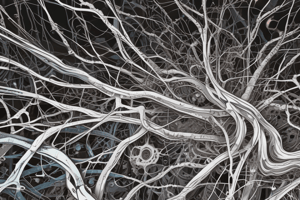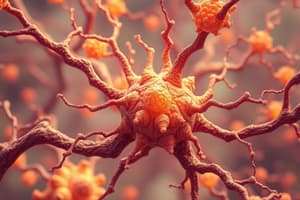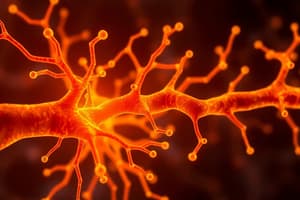Podcast
Questions and Answers
According to research, what is the primary impact of attempting to perform multiple cognitive tasks simultaneously?
According to research, what is the primary impact of attempting to perform multiple cognitive tasks simultaneously?
- It enhances overall cognitive function by promoting neural plasticity.
- It allows for more efficient use of time, as multiple tasks are addressed concurrently.
- It reduces accuracy and speed as the brain rapidly switches focus between tasks. (correct)
- It increases both speed brought on by enhanced focus, and accuracy due to improved information processing efficiency.
Which combination of tasks is most likely to result in decreased performance, according to the principles of cognitive load?
Which combination of tasks is most likely to result in decreased performance, according to the principles of cognitive load?
- Driving (automatic) while listening to music (cognitive).
- Texting on your phone (cognitive) while operating a vehicle (cognitive). (correct)
- Listening to a podcast (automatic) while completing a crossword puzzle (cognitive).
- Walking (automatic) while simultaneously chewing gum (automatic).
A student is struggling to understand a complex scientific concept. In terms of Cognitive Load Theory, which strategy would best address the intrinsic load?
A student is struggling to understand a complex scientific concept. In terms of Cognitive Load Theory, which strategy would best address the intrinsic load?
- Using old notes to relate the material to something they already know.
- Studying in a quiet environment to minimize distractions.
- Breaking down the concept into smaller, more manageable parts. (correct)
- Listening to white noise to reduce cognitive distractions.
In the context of the serial position effect, which phenomenon explains why a person is most likely to remember the first few items in a grocery list?
In the context of the serial position effect, which phenomenon explains why a person is most likely to remember the first few items in a grocery list?
Which of the following strategies would be MOST effective for reducing extraneous cognitive load while studying?
Which of the following strategies would be MOST effective for reducing extraneous cognitive load while studying?
What is the primary difference between Short-Term LTP (S-LTP) and Long-Term LTP (L-LTP)?
What is the primary difference between Short-Term LTP (S-LTP) and Long-Term LTP (L-LTP)?
According to the de novo protein synthesis hypothesis, what would be the result of blocking translation after high-frequency stimulation (HFS)?
According to the de novo protein synthesis hypothesis, what would be the result of blocking translation after high-frequency stimulation (HFS)?
What conclusion can be drawn from Sutton & Schuman's (2006) experiment, where L-LTP still occurred in dendrites that were cut off from the soma?
What conclusion can be drawn from Sutton & Schuman's (2006) experiment, where L-LTP still occurred in dendrites that were cut off from the soma?
Why is CREB activation considered important in the context of Long-Term Potentiation (LTP)?
Why is CREB activation considered important in the context of Long-Term Potentiation (LTP)?
What is the role of BDNF in LTP maintenance?
What is the role of BDNF in LTP maintenance?
How does Arc contribute to the stabilization of synaptic changes during LTP?
How does Arc contribute to the stabilization of synaptic changes during LTP?
What is the primary function of the 'synaptic tag' in the Synaptic Tag and Capture hypothesis?
What is the primary function of the 'synaptic tag' in the Synaptic Tag and Capture hypothesis?
In the context of memory, what role does attention play during encoding?
In the context of memory, what role does attention play during encoding?
A researcher is investigating how individuals learn new routes in a city. Which component of working memory is MOST directly involved in storing and manipulating a mental map of the city?
A researcher is investigating how individuals learn new routes in a city. Which component of working memory is MOST directly involved in storing and manipulating a mental map of the city?
An individual is presented with a series of words. According to the levels of processing framework, which approach would lead to the BEST recall of the words later?
An individual is presented with a series of words. According to the levels of processing framework, which approach would lead to the BEST recall of the words later?
During a problem-solving task, an individual needs to shift their attention between different aspects of the problem to find a solution. Which brain region is MOST crucial for this attentional switching?
During a problem-solving task, an individual needs to shift their attention between different aspects of the problem to find a solution. Which brain region is MOST crucial for this attentional switching?
A student is trying to remember a list of historical dates. Which strategy would shift the encoding from maintenance to elaborative rehearsal?
A student is trying to remember a list of historical dates. Which strategy would shift the encoding from maintenance to elaborative rehearsal?
A cognitive psychologist is interested in studying the effects of distraction on working memory performance. According to the Atkinson-Shiffrin model, what role does working memory play in this scenario?
A cognitive psychologist is interested in studying the effects of distraction on working memory performance. According to the Atkinson-Shiffrin model, what role does working memory play in this scenario?
An individual struggles to notice a friend waving at them while deeply engrossed in a phone conversation. This is an example of?
An individual struggles to notice a friend waving at them while deeply engrossed in a phone conversation. This is an example of?
A child initially believes that all birds can fly, which is their existing schema of birds. After seeing a penguin at the zoo, they adjust their understanding of birds to include both flying and non-flying types. Which process describes this change in schema?
A child initially believes that all birds can fly, which is their existing schema of birds. After seeing a penguin at the zoo, they adjust their understanding of birds to include both flying and non-flying types. Which process describes this change in schema?
During a Wisconsin Card Sorting Test (WCST), a participant initially sorts cards by color, but then the rule changes and they need to sort by shape. Which cognitive function is MOST directly being tested by this rule change?
During a Wisconsin Card Sorting Test (WCST), a participant initially sorts cards by color, but then the rule changes and they need to sort by shape. Which cognitive function is MOST directly being tested by this rule change?
Flashcards
Encoding
Encoding
Taking in and organizing new information for long-term storage.
Selective Attention
Selective Attention
Focusing on one thing while ignoring distractions.
Inattentional Blindness
Inattentional Blindness
Failing to see something obvious because attention is elsewhere.
Phonological Loop
Phonological Loop
Signup and view all the flashcards
Visuospatial Sketchpad
Visuospatial Sketchpad
Signup and view all the flashcards
Schemas
Schemas
Signup and view all the flashcards
Assimilation
Assimilation
Signup and view all the flashcards
Elaborative Rehearsal
Elaborative Rehearsal
Signup and view all the flashcards
S-LTP
S-LTP
Signup and view all the flashcards
L-LTP
L-LTP
Signup and view all the flashcards
De Novo Protein Synthesis Hypothesis
De Novo Protein Synthesis Hypothesis
Signup and view all the flashcards
Local mRNA Translation in Dendrites
Local mRNA Translation in Dendrites
Signup and view all the flashcards
Genomic Signaling Hypothesis
Genomic Signaling Hypothesis
Signup and view all the flashcards
BDNF
BDNF
Signup and view all the flashcards
Arc
Arc
Signup and view all the flashcards
Synaptic Tag and Capture Hypothesis
Synaptic Tag and Capture Hypothesis
Signup and view all the flashcards
Task-Switching
Task-Switching
Signup and view all the flashcards
Cognitive Load
Cognitive Load
Signup and view all the flashcards
Intrinsic Load
Intrinsic Load
Signup and view all the flashcards
Extraneous Load
Extraneous Load
Signup and view all the flashcards
Primacy Effect
Primacy Effect
Signup and view all the flashcards
Study Notes
- Memory involves cellular and molecular mechanisms.
- Durability of Long-Term Potentiation (LTP) is a key aspect of memory.
S-LTP vs. L-LTP:
- Short-Term LTP (S-LTP) is temporary and doesn't require new protein synthesis.
- Long-Term LTP (L-LTP) lasts longer and requires protein synthesis for maintenance.
De Novo Protein Synthesis Hypothesis:
- Long-term maintenance requires translation of new proteins, even though initial LTP changes are supported by modifications.
- Studies show that blocking translation after high-frequency stimulation (HFS) prevents L-LTP but still allows S-LTP.
- Local mRNA translation in dendrites is crucial for sustaining LTP.
Local mRNA Translation in Dendrites:
- Sutton & Schuman (2006) found that L-LTP still occurred when dendrites were cut off from the soma.
- Local protein synthesis in dendrites can maintain LTP on its own.
- Bradshaw (2003) found that blocking translation in dendrites prevented L-LTP, while blocking it in the soma did not.
- mRNA translation in dendrites is necessary for LTP.
Genomic Signaling Hypothesis:
- Transcription factors (e.g., CREB) help produce the mRNA needed for L-LTP.
- Strong depolarization triggers a cascade that enhances transcription of key proteins.
CREB Activation Mechanisms:
- Molecules activated at the synapse travel to the soma and phosphorylate CREB.
- Calcium influx in the soma directly activates CREB, which is faster and more efficient.
Key Molecules in LTP:
- BDNF is released alongside glutamate.
- BDNF enhances local mRNA translation in dendritic spines.
- BDNF is essential for LTP maintenance.
- Arc is quickly transcribed and translated after synaptic activity.
- Arc helps stabilize synaptic changes by regulating actin.
Synaptic Tag and Capture Hypothesis:
- Active synapses get a "tag" that allows them to capture plasticity molecules.
- Strong stimulation provides both a tag and the ability to translate molecules.
- Weak stimulation only provides a tag but can capture molecules from other synapses.
- This allows efficient use of available plasticity molecules.
- This integrates weak inputs into long-term memory.
Encoding and Attention in Memory:
- Attention focuses on important information while ignoring distractions.
- Working Memory is a short-term memory system that processes and stores information temporarily.
- Encoding is the process of taking in and organizing new information for long-term storage.
Brain Regions Involved:
- Parietal Cortex combines sensory information (e.g., vision and touch).
- Prefrontal Cortex (PFC) controls focus, decision-making, and planning.
- Anterior Cingulate Cortex (ACC) helps switch attention and adapt to new information.
Key Experiments:
- Wisconsin Card Sorting Task (WCST) tests problem-solving and flexibility (related to the PFC, ACC, and parietal cortex).
- Visual Paired Comparison Task (VPC) tests recognition memory by measuring attention to new images.
- Novel Object Recognition (NOR) Task tests how animals recognize new vs. familiar objects (perirhinal cortex & hippocampus).
Types of Attention:
- Selective Attention: Focuses on one thing while ignoring distractions.
- Inattentional Blindness: Failing to see something obvious because attention is elsewhere.
- Selective Inattention: Ignoring stressful or unnecessary stimuli.
Good or Bad?
- Can be helpful for focus or harmful if it causes one to miss important details.
Working Memory Components:
- Phonological Loop processes verbal info (e.g., remembering a phone number).
- Visuospatial Sketchpad stores visual and spatial information (e.g., mental maps).
- Central Executive controls attention and decides what's important.
- Episodic Buffer connects working memory to long-term memory.
Schemas and Memory Organization:
- Schemas are mental "folders" that group related ideas.
- Stronger schemas lead to better memory.
- Assimilation: Adding new info to an existing schema.
- Accommodation: Changing a schema to fit new info.
Levels of Processing (Memory Strength):
- Shallow Processing involves basic features (e.g., capital letters).
- Intermediate Processing involves sound-based features (e.g., rhymes).
- Deep Processing involves meaning-based understanding and is best for memory.
Memory Strategies:
- Maintenance Rehearsal: Repeating information (good for short-term memory).
- Elaborative Rehearsal: Connecting new info to existing knowledge (best for long-term memory).
Working Memory and Cognitive Load:
- Sensory Memory (SM) holds raw sensory input briefly.
- Short-Term Memory (STM) holds small amounts of info temporarily.
- Long-Term Memory (LTM) stores information for extended periods.
- Working Memory links SM and LTM, helping to process new info and retrieve old info.
Multitasking and Task Performance:
- Multitasking is a myth, reducing accuracy and speed, as the brain switches between tasks.
- Multitasking leads to lower performance and increased fatigue.
Automatic vs. Cognitive Tasks:
- Automatic Task + Automatic Task is easy (e.g., walking + chewing gum).
- Automatic Task + Cognitive Task is possible (e.g., driving + music).
- Cognitive Task + Cognitive Task is hard (e.g., texting while driving).
Cognitive Load Theory (CLT):
- Intrinsic Load is task difficulty (e.g., complex math problems).
- Extraneous Load consists of unnecessary distractions (e.g., noisy environment).
- Germane Load is the effort to connect new info with existing knowledge.
Element Interactivity:
- Low Interactivity involves simple tasks (e.g., memorizing a list).
- High Interactivity involves complex tasks with multiple steps (e.g., writing an essay).
Effects of Noise:
- Physical Noise (e.g., loud music) impacts learning.
- Cognitive Noise (e.g., complicated instructions) impacts learning.
- Too much noise makes learning harder.
How To Reduce Cognitive Load While Studying:
- Extraneous Load: Remove distractions by finding a quiet study space.
- Intrinsic Load: Break difficult material into smaller sections.
- Germane Load: Use old notes to connect new info.
The Serial Position Effect:
- Primacy Effect: Remembering the first items on a list (long-term memory).
- Recency Effect: Remembering the last items (short-term memory).
- Von Restorff Effect: Unusual or different items stand out.
Studying That Suits You
Use AI to generate personalized quizzes and flashcards to suit your learning preferences.



